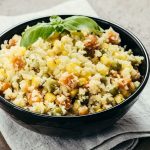
When cold weather hits, a hot bowl of chili is a great way to fuel up. High-protein turkey chili contains a lot less fat than traditional recipes, yet can deliver all the flavor. Turkey is lower in calories than beef — as long as you buy lean ground turkey breast. This recipe also uses low-calorie vegetables for additional flavor (and fiber). Turkey Chili 1 pound ground turkey breast 1/4 teaspoon salt 1 tablespoon light olive or canola oil 2 teaspoons ground cumin 2 teaspoons sweet chili powder 1 teaspoon fresh rosemary 1 large onion, chopped 2 carrots, scrubbed and chopped 2 celery stalks, trimmed, peeled and chopped 1/4 cup tomato paste 28-ounce can chopped tomatoes 4 cups low-sodium chicken broth 15-ounce can pinto beans Your choice of toppings Sprinkle the turkey with salt. Heat a large stockpot on high heat and add the oil. When hot, add the turkey, but don’t stir it. (Allowing it to brown in the pan for two to three minutes adds savory flavor without needing higher quantities of fat and salt.) Flip to brown on the other side for one minute and then start to break it up with a spatula. Sprinkle with the cumin, chili powder and rosemary. Add onions, carrots and celery. Cook two to three minutes, stirring occasionally. Then add tomato paste, chopped tomatoes, broth and beans.… read on >





































